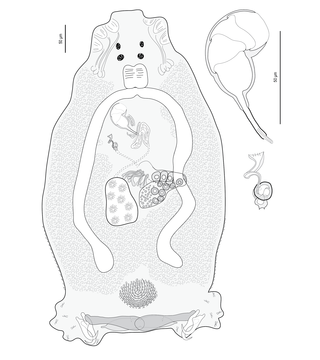
Pseudorhabdosynochus manifestus is a diplectanid monogenean parasite first found in host Epinephelus malabaricus near Nouméa, between its secondary gill lamellae. It can infest its host by the hundreds. It was ascribed that name because it was the most abundant species found while its descriptive study was taking place. As appreciated from studying juvenile specimens, the development of female organs precedes that of male organs in this species and is likely the case in other Pseudorhabdosynochus species.
Pseudorhabdosynochus auitoe is a diplectanid monogenean parasitic on the gills of the Highfin grouper, Epinephelus maculatus. It was described in 2007.
Pseudorhabdosynochus buitoe is a diplectanid monogenean parasitic on the gills of the Highfin grouper, Epinephelus maculatus. It has been described in 2007.
Pseudorhabdosynochus duitoe is a diplectanid monogenean parasitic on the gills of the highfin grouper, Epinephelus maculatus. It has been described in 2007.
Pseudorhabdosynochus euitoe is a diplectanid monogenean parasitic on the gills of the Highfin grouper, Epinephelus maculatus. It has been described in 2007.
Pseudorhabdosynochus fuitoe is a diplectanid monogenean parasitic on the gills of the highfin grouper, Epinephelus maculatus. It has been described in 2007.
Pseudorhabdosynochus guitoe is a diplectanid monogenean parasitic on the gills of the Highfin grouper, Epinephelus maculatus. It has been described in 2007.
Pseudorhabdosynochus huitoe is a diplectanid monogenean parasitic on the gills of the highfin grouper, Epinephelus maculatus. It was described in 2007.

Pseudorhabdosynochus malabaricus is a diplectanid monogenean parasitic on the gills of the malabar grouper, Epinephelus malabaricus. It has been described in 2007.

Pseudorhabdosynochus maternus is a diplectanid monogenean parasitic on the gills of the Malabar grouper, Epinephelus malabaricus. It has been described in 2007.
Pseudorhabdosynochus cyathus is a diplectanid monogenean parasitic on the gills of the grouper Epinephelus howlandi. It has been described in 2006.
Pseudorhabdosynochus calathus is a diplectanid monogenean parasitic on the gills of the grouper Epinephelus rivulatus. It has been described in 2006.

Pseudorhabdosynochus morrhua is a diplectanid monogenean parasitic on the gills of the grouper Epinephelus morrhua. It has been described in 2008.
Pseudorhabdosynochus quadratus is a species of diplectanid monogenean that is parasitic on the gills of the white-streaked grouper Epinephelus ongus. It was described in 2011.
Pseudorhabdosynochus crassus is a species of diplectanid monogenean that is parasitic on the gills of the camouflage grouper Epinephelus polyphekadion. It was described in 2011.
Pseudorhabdosynochus dionysos is a species of diplectanid monogenean that is parasitic on the gills of the camouflage grouper Epinephelus polyphekadion. It was described in 2011.
Pseudorhabdosynochus chinensis is a species of diplectanid monogenean parasitic on the gills of the greasy grouper, Epinephelus tauvina. It was described in 2001.
Pseudorhabdosynochus youngi is species of diplectanid monogenean parasitic on the gills of the blacktip grouper, Epinephelus fasciatus. It was described in 2009.
Pseudorhabdosynochus shenzhenensis is a species of diplectanid monogenean parasitic on the gills of the grouper Epinephelus coioides. It was described in 2005.
Pseudorhabdosynochus summanoides is a species of diplectanid monogenean parasitic on the gills of the orange-spotted grouper Epinephelus coioides. It was described in 2005.




